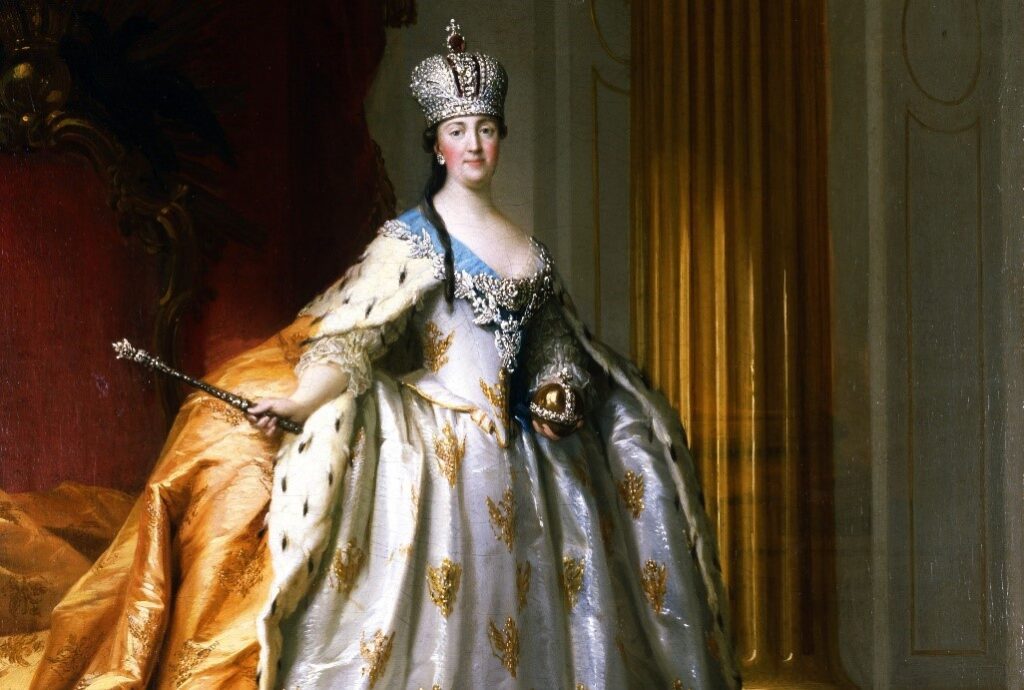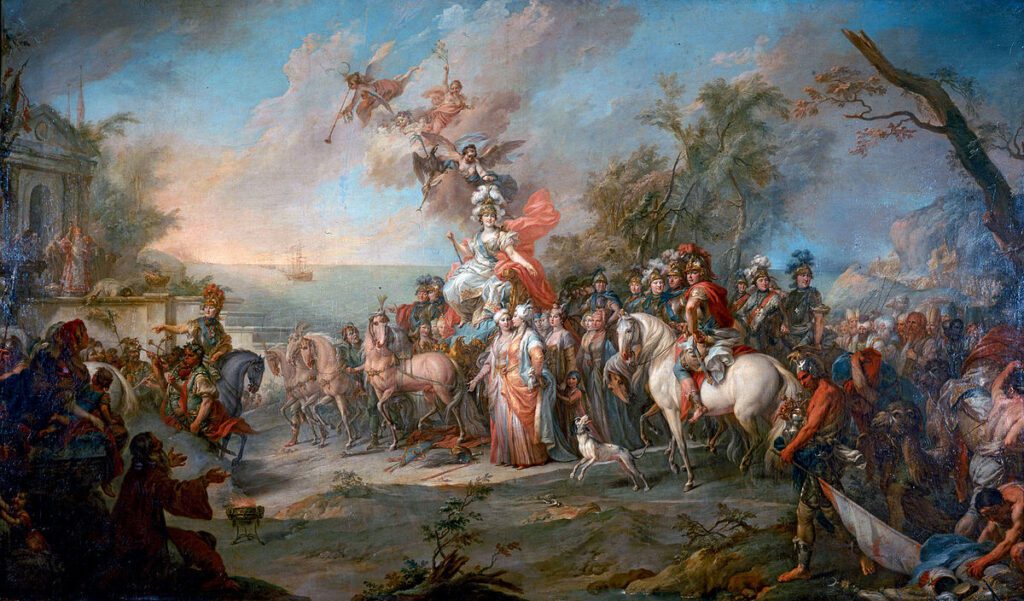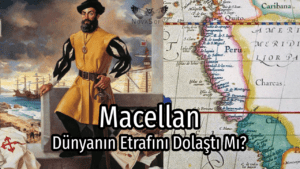Maritime Activities of the Russians in the Mediterranean in the XIII Century

The XVI century was a turning point for Russia. As a matter of fact, the centralization policies that started in the reign of Ivan III reached their peak during the reign of Ivan IV. Within a century, Russian Tsarism had established its control over a large part of the territory of present-day Western Russia. He invaded Astrakhan in 1552 and Kazan in 1556 and managed to eliminate the threats from the steppe.
One of the great requirements of Russia in the XVII century was the need to open up to the Black Sea and the Baltic Sea. As a result of meeting this need, Russia would go to the way of creating a trade network with various countries through the seas and profiting from it. The Russian rulers, especially Peter the Great, understood this fact.
The end of the same century was a favorable period for the expansion of Russia. As a matter of fact, as we mentioned above, Russia had ensured dominance and stability in its domestic politics, had become centralized in the military and administrative mechanism, and had finally become in need of expansion. However, Russia still did not have a navy within a century. The first official navy was created by Peter the Great in 1696 to protect the Sea of Azov[1].

The first years of Peter the Great’s rule were marked by struggles with the Crimean Khanate and the Ottoman Empire. In 1695, the Russian army attacked Azov, but was not victorious. The result of the Filvaki failure showed Peter that the fortress of Azov had to be besieged by sea in order to be captured. As a result of this siege, there would be a shortage of food in Azov and the capture of the region would be easier. Of course, it was necessary to create a navy for this purpose.
Seeing this necessity, Peter declared war against the Turks and Tatars on November 27, 1695, and immediately began to build a navy in Preobrazhensk near Moscow. At the same time, there was another small old fleet in the Voronezh region. As a result of the unification of the navies and their integration with the army, the fortress of Azov was captured in July 1696[2].
Peter the Great, thinking he had settled the issue in the south, embarked on a grand tour of Europe in 1697 under the pseudonym of Artillery Petro Mikhailov, with an embassy delegation. The purpose of the delegation was to form an anti-Turkish coalition, but Peter the Great believed it was more beneficial to concentrate on the Baltic region.
During this journey, Peter had the opportunity to observe scientific and technological developments in Europe. He even worked as a carpenter in a shipyard in the Netherlands. He studied the navies of the period. When he returned, he built the city of St. Petersburg in 1703. At the same time, he began to create a Baltic navy.
He established a port in Kronstadt and as a result of the ships produced there; By 1725, 36 ships, 16 frigates, 70 rowing warships and over 200 boats were available in the Baltic navy. When Peter died, he left behind 48 warships, 787 smaller and complementary ships, and 28,000 soldiers who served them. So much so that the British government was worried about the sudden rise of the Russian navy and recalled its men who had served in Russia in 1719. As Peter stated in the preamble to the Maritime Law; “A ruler with only a land army had only one arm, and a ruler with a navy had two arms”[3]
By 1736, a new war had broken out between the Ottomans and Russia. The Russians, under the command of von Münnich, succeeded in capturing Orkapi, Özü, Azov. At the same time, he was at war against the Ottomans in Austria. Russia, which was trying to make Austria continue the war with the Ottoman Empire, seized Hotin Castle and the city of Iaşi to discourage the idea of peace.
However, upon Austria’s withdrawal from the war, Russia was afraid that the Ottoman Empire would send all its forces against itself. For this reason, when the Russian troops withdrew from the region, Özi again fell into the hands of the Ottomans and the Ottoman Empire and Russia signed the Treaty of Belgrade on September 18, 1739. This treaty was not enough for Russia, as the Russians did not obtain the right to maintain a navy in the Black Sea[4].
Peter’s geopolitical and strategic policy of depth was completed nearly a century later by Tsaritsa Catherine the Great. Catherine II achieved a significant success in foreign policy and especially in Russia’s Mediterranean policy. During his term, the policy of opening up to warm seas was stated as the main goal. Taking advantage of political conditions, he seized the Sea of Azov and, in part, the Black Sea coast and opened the way to the Mediterranean. During this clever Tsarice period, a special importance was attached to the navy. Both the number of galleys and the quality were increased[5].

In 1763, a merchant named Vladimirov founded a commercial company to trade with Mediterranean countries. Katerina became a partner in this company by giving 10 thousand rubles. On October 23, 1763, the construction of a military ship called “Hope for Kindness” began in Saint Petersburg, which was to embark on Mediterranean expeditions. In August 1764, the navy sailed to the Mediterranean under the flag of a merchant ship. According to the secret instruction given to the ship’s captain Plesheev, they were to collect information and pictures of the Mediterranean coast and its ports[6]. This team was joined by Vilim Fondezin, P. Anchikov, İ. Names such as Artsibashev also participated[7].
In fact, this event in 1763 was not the first attempt to get to know the Mediterranean world. As a matter of fact, as early as 1697, Peter the Great sent a ship led by P. A. Tolstoy to the Mediterranean for the purpose of exploration. Tolstoy visited Malta, Italy; He traveled every inch of the Black Sea, the Mediterranean and the Aegean, and presented a detailed analysis of the ports in Istanbul to the emperor[8]. The Russian Emperors thus tried to recognize the Mediterranean and were successful. After the expeditions, the time was close when large military navies would move to the Mediterranean for combat purposes. The campaigns that sailed from the Baltic Sea to the Mediterranean in the XVIII and XIX centuries and were involved in various naval battles there were to be called Arhipelagskie Ekspeditsii, or Voyages to the Sea of Islands, in the historical literature. The first voyage was to be carried out in 1768, the second in 1806-1807, and the third in 1827.

When the Ottoman-Russian war broke out in 1768, Catherine decided to attack the Ottoman Empire from the Mediterranean as well. The Russians were provoking the Greeks in this region and trying to push them into rebellion. Based on this aim, Catherine sent a fleet to the Mediterranean in accordance with her plan to incite the peoples of the Mediterranean to revolt. The navy sent by Russia to the Mediterranean for the first time consisted of seven ships named “European”, “Svyatoslav”, “Holy Evstafiy Plakida”, “Three Ierarh”, “Holy Ionuariy”, “Northern Eagle” and “Three High Priests”, headed by Admiral Spridov. The ships consisted of a total of 640 guns and a crew of 5582.
Since the Russians had good relations with the British at that time, the aforementioned Russian ships had the opportunity to rest in the ports belonging to the British on the way to the Mediterranean and to meet the needs of their ships.[9] Before the navy had reached the Mediterranean , Catherine II appointed Graf Orlov as the head of Russia’s Mediterranean Forces. Graf Orlov soon added the Greek sailors and recovered the fleet that had been broken down on the way. The Greeks, who saw the Russian navy in the Mediterranean as planned by Catherine II, began to rebel against the Ottoman Empire and to act together with the Russians.
The Ottoman State, which learned from the French diplomatic channel that the Russian navy was on its way to the Mediterranean, did not succeed in preventing uprisings and not letting the Russians into the Mediterranean, although it took some measures in the region. The Ottoman navy, who learned that Russian ships were coming to the Mediterranean, went out to meet them. On July 5-7, 1770, a major battle took place between the Russian and Ottoman navies.
At the end of this war, known as the Battle of Çeşme Sea, the Ottoman navy was severely defeated by the Russians. At the end of this war, the Russian navy gained prestige and confidence in the Mediterranean. This victory of the Russians also affected the outcome of the Turkish-Russian war and the Ottomans had to share the Black Sea with the Russians. Until the signing of the Treaty of Küçük Kaynarca, the Russian navy continued to travel in the region by piracy in the Mediterranean[10]. As a result, the First Island Sea Expedition of 1768-1770 was successful.
As a result of the Ottoman-Russian War of 1768-1774, the Treaty of Küçük Kaynarca was signed. The articles of this treaty concerning the Mediterranean were as follows: Russia would withdraw its troops from the occupied Mediterranean Islands and Georgia, Bessarabia, Wallachia and Buğdan. In all the seas belonging to the two States, merchant ships and merchants belonging to the parties would be able to move freely and trade, and Russian merchant ships would be able to pass freely through the straits[11].
These commercial transits were not always well-intentioned. Russian merchant ships, taking advantage of the right of free passage through the Straits, were constantly carrying illegal weapons and ammunition to the Greeks and Montenegrins living on the islands in the Aegean Sea and provoking them to revolt. With this treaty, the Russians began to see themselves as the patrons of the Christians in the Ottoman Empire, and the Greek Project emerged during this period[12].
After the Russian Empire annexed the Crimea in 1783, it embarked on the construction of a large shipyard in Sevastopol. The aim was to establish dominance over the entire Black Sea and to be able to move freely in the Mediterranean. Dissatisfied with the Russian annexation of Crimea, the Ottoman Empire declared war in 1787. Meanwhile, naval supremacy in the Black Sea was in the hands of the Ottomans. In the two battles fought at the mouth of the Dnieper River in 1788, the Ottomans had the upper hand, but the victory was the Russians. The Ottoman navy had lost fifteen ships and nearly three thousand personnel in these battles, while the loss of the Russians was 1 ship and 18 personnel[13].
After the wars that took place between the Russian and Ottoman Empires, the end of the XVIII century witnessed the rapprochement of the two states. By the end of the century, the two states had joined an anti-French coalition. In 1798, a fleet under the command of Ushakov, 6 warships, 7 frigates and many landing ships, left Sevastopol and headed for the Mediterranean. This navy was combined with the Ottoman navy led by Kadir Bey in Istanbul. The joint fleet occupied islands such as Kefalonia, Lefkas and Zakynthos for 6 weeks. On February 18, 1799, naval units landed amphibious on the island of Corfu, and two days later the island was taken over. As a result of the campaign, the Russians gained a base in the Mediterranean and maintained a fleet there[14].



At the beginning of the XIX century, the Ottomans began to pass the Russian navies through the Straits without any problems, thus changing the legal status of the Straits. Another innovation experienced for the Russians in this period was the transfer of the Russian navy registered to the Baltic navy to the Black Sea. After the wars against the French in the Mediterranean, in 1809, the Russian Tsar I. Alexander decided to withdraw the Mediterranean fleet to the Black and Baltic seas. However, the departure of the Russian navy from the Mediterranean did not take long, and with the beginning of the wars, the navy returned to the Mediterranean. At the beginning of the nineteenth century, the Russian Empire became the “European Gendarmerie” after its successes in the Mediterranean, especially after its defeat of the Ottoman navy in 1827 and the exit of the Greeks from Ottoman rule. For example, between 1881 and 1885, Russian navies made about 150 voyages in the Mediterranean[15].
As a result, the Russians’ acquaintance with the Mediterranean world took place as early as the IX century. However, until the XVII century, as a result of the political events that took place, their geopolitical position did not allow them to open up to the Mediterranean. In the XVI century, when the Russians became a central entity and reached a state suitable for expansion, they chose the Black Sea and the Mediterranean as their targets. In line with this goal, they saw the need for a strong navy and were able to create a large navy in a short time. As a result, they organized many expeditions to the Mediterranean in the XVIII century, and in the XIX century they became an active force in this sea gelmişlerdir.
BIBLIOGRAPHY
“Sredizemnomorskiy Pohod 1798-1800”, Bolşaya Rossiyskaya Entsiklopediya, T. XXXI, Moskva, 2016, s. 113-114.
ANDERSON, M. S., “Great Britain and the Russian Fleet, 1769-70”, The Slavonic and East European Review, Vol. XXXI, No. 76, 148-163.
DERVİŞ, Leyla, DEVRİSHEVA, Khalida, “Çarlık Rusyası’nın Akdeniz Politikası’nın Arka Planı”, Cedrus, Cilt III, 2015, 351-364.
EFE, Haydar, KIZIL, Murat, “Osmanlı’nın Kuzey ve Doğu Politikası ve Rusya’nın ‘Sıcak Denizlere İnme Politikası’ Kapsamında Şekillenen Doğu Sınırları”, KAÜİİBFD, Cilt IX, Sayı 17, 297-334.
HOSKİNG, Geoffrey, Rusya ve Ruslar; Erken Dönemden 21. Yüzyıla, İstanbul, 2015.
İNALCIK, Halil, “Yeni Vesikalara Göre Kırım Hanlığı’nın Osmanlı Tâbiliğine Girmesi ve Ahidname Meselesi”, Belleten, Cilt VIII, Sayı 30, 185-230.
MAVRODİN, V. V., Naçalo Morehodstva na Rusi, Leningrad, 1950.
ORTAYLI, İlber, “XVIII. Yüzyıl Türk-Rus İlişkileri”, Türk-Rus İlişkilerinde 500 Yıl; 1491-1992, Ankara, 1999, 125-136.
Povest Vremennıh Let, Per. D. S. Lihaçev, O. V. Tvorogov, St. Petersburg, 2012.
RİASONOVSKY, Nicholas V., STEİNBERG, Mark D., Rusya Tarihi; Başlangıçtan Günümüze, Çev. Figen Dereli, İstanbul, 2014.
SMİLYANSKAYA, İ. M., VELİJEV, M. B., SMİLYANSKAYA, E. B., Rossiya v Sredizemnomorye; Arhangelskaya Ekspeditsiya Ekaterinı Velikoy, Moskova, 2011.
Sredizemnomorskiy Pohod Uşakova”, Sovetskaya İstoriçeskaya Entsiklopediya, Red. E. M. Jukov, T. XVI, 760-761.
ŞİROKORAD, A. B., Rossiya na Sredizemnom More, Moskova, 2013.
ŞİROKORAD, A. B., Rusların Gözünden 240 Yıl Kıran Kırana Osmanlı-Rus Savaşları, Red. Nergize Turaeva, İstanbul, 2013.
The Russian Primary Chronicle, Laurentian Text, Trans. and Ed. Samuel Hazzard Cross, P. Sherbowitz-Wetzor, Cambridge, 1953.
VERNADSKY, George, Rusya Tarihi, Çev. Doğukan Mızrak, Egemen Ç. Mızrak, İstanbul, 2015.
WATTZ, Anthony J., The İmperial Russian Navy, New York, 1990.
[1] Leyla Derviş, Khalida Devrisheva, a.g.m., s. 354-355.
[2] Anthony J. Wattz, The İmperial Russian Navy, New York, 1990, s. 8; George Vernadsky, Rusya Tarihi, Çev. Doğukan Mızrak, Egemen Ç. Mızrak, İstanbul, 2015, s. 180; A. B. Şirokorad, Rusların Gözünden 240 Yıl Kıran Kırana Osmanlı-Rus Savaşları, Red. Nergize Turaeva, İstanbul, 2013, s. 68-73.
[3] Geoffrey Hosking, a.g.e., s. 259-261; George Vernadsky, a.g.e., s. 195; Nicholas V. Riasonovsky, Mark D. Steinberg, Rusya Tarihi; Başlangıçtan Günümüze, Çev. Figen Dereli, İstanbul, 2014, s. 231-232.
[4] George Vernadsky, a.g.e., s. 211; Haydar Efe, Murat Kızıl, a.g.m., s. 307-308; Anthony J. Wattz, a.g.e., s. 10; A. B. Şirokorad, Osmanlı-Rus Savaşları, s. 97-126.
[5] Leyla Derviş, Khalida Devrisheva, a.g.m., s. 355.
[6] Leyla Derviş, Khalida Devrisheva, a.g.m., s. 355; A. B. Şirokorad, Rossiya na Sredizemnom More, s. 11.
[7] İ. M. Smilyanskaya, M. B. Velijev, E. B. Smilyanskaya, Rossiya v Sredizemnomorye; Arhangelskaya Ekspeditsiya Ekaterinı Velikoy, Moskova, 2011, s. 35.
[8] A.g.e., s. 30; Pyotr Alekseyeviç Tolstoy, Rusya’nın İstanbul’daki ilk elçisidir. Osmanlı İmparatorluğu’nun siyasi, askeri ve toplumsal durumu hakkında kapsamlı raporlar sunmuştur. Prut Savaşı esnasında Osmanlılar tarafından hapsedilmiştir. Bkz. İlber Ortaylı, “XVIII. Yüzyıl Türk-Rus İlişkileri”, Türk-Rus İlişkilerinde 500 Yıl; 1491-1992, Ankara, 1999, s. 125.
[9] Rusların 1768-70 yılları arasında gerçekleştirdiği bu deniz seferi esnasında İngiltere’nin tutumu için bkz. M. S. Anderson, “Great Britain and the Russian Fleet, 1769-70”, The Slavonic and East European Review, Vol. XXXI, No. 76, 148-163.
[10] Leyla Derviş, Khalida Devrisheva, a.g.m., s. 356-357; A. B. Şirokorad, Osmanlı-Rus Savaşları, s. 171-190; A. B. Şirokorad, Rossiya na Sredizemnom More, s. 32-41; Anthony J. Wattz, a.g.e., s. 10-11; George Vernadsky, a.g.e., s. 212.
[11] Haydar Efe, Murat Kızıl, a.g.m., s. 309.
[12] Leyla Derviş, Khalida Devrisheva, a.g.m., s. 358.
[13] Anthony J. Wattz, a.g.e., s. 11.
[14] “Sredizemnomorskiy Pohod Uşakova”, Sovetskaya İstoriçeskaya Entsiklopediya, Red. E. M. Jukov, T. XVI, s. 760-761; “Sredizemnomorskiy Pohod 1798-1800”, Bolşaya Rossiyskaya Entsiklopediya, T. XXXI, Moskva, 2016, s. 113.
[15] Leyla Derviş, Khalida Devrisheva, a.g.m., s. 360-361.



